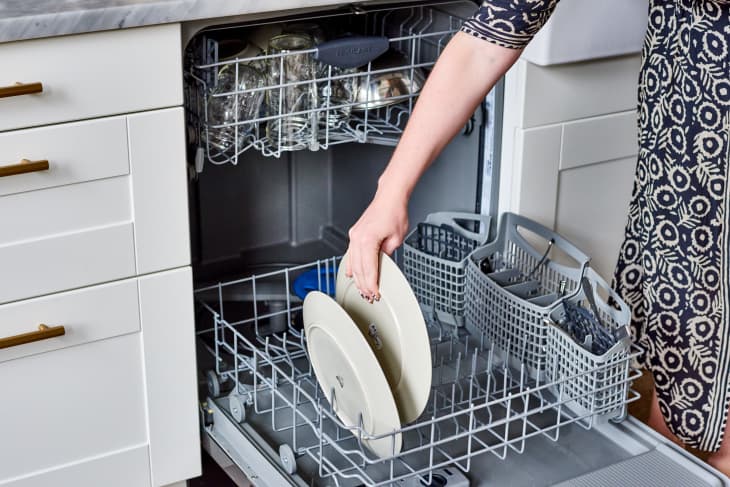12 Rules for Loading a Dishwasher “Correctly,” According to Cleaning Experts
There’s no right way to load a dishwasher … right? Well, there are plenty of things you can do right and wrong when loading the dishwasher, according to experts. You may be stuffing dishes, glasses, and silverware into your dishwasher in a completely hodge-podge fashion, even wondering why you can’t cram in as much as you want in a single dishwashing load. Then, when you go to put your dishes away, you notice they’re not as clean as you’d like. So, what gives?
Before you throw your hands up and turn to — gasp! — washing your dishes by hand (by the way, here’s more on the great dishwasher vs. hand-washing debate), here are some expert tips and tricks that will help you get the most out of your dishwasher (read: the cleanest dishes possible). Whether you’re loading a countertop dishwasher or a full-sized one, let’s break down the right way to load a dishwasher, according to cleaning experts. You’re welcome!
1. Skip the sink rinsing.
In the olden days, it was customary to wash dishes by hand before putting them in the dishwasher. Nowadays, though, not only is that overly time-consuming, but it’s also a pretty big waste of water. “If you have a really old dishwasher, then it may be necessary. However, most modern dishwashers are capable of cleaning dishes without being pre-washed,” says Jessica Samson, cleaning expert at The Maids. “The dishwasher is actually much more efficient than hand-washing, and pre-washing is a waste of water and time for most.”
2. Mix up your silverware.
If you’re as Type A as I am, then the thought of mixing different types of flatware and utensils together — not to mention turning them different ways — is enough to create at least a little panic. Don’t worry, because it’s actually better for both cleaning and safety purposes. Samson recommends loading knives with the handle up to avoid cutting yourself (and here’s how to avoid the hazard in a countertop dish rack). Meanwhile, load spoons and forks with the handles down for proper cleaning.
3. Face plates inward.
Most dishwashers have sprayer arms radiating from the bottom center of the machine, which stop a few inches from the interior walls. If you place plates facing outward, the jets of water might not be able to reach the ones facing the wall.
4. Don’t block the sprayer and jets.
If you put something over the sprayer or jets (like a large bowl), that item will get clean, but the other dishes won’t. Make sure you know where the sprayer and jets are, and then load dishes around them.
5. Load items at an angle.
When it comes to loading your dishwasher, angles matter. “The goal is to load everything at an angle to ensure it is properly cleaned,” says Samson.
6. Load from back to front.
It can be tempting to open the dishwasher a crack and just stick something in there — but that can cause some loading problems later on. Samson recommends moving from the back to the front on both the top and bottom racks.
7. Make sure nothing is sticking out.
As you’re cramming in plates or stuffing a silverware basket, make sure no taller or larger pieces stick out; otherwise, you could damage the dishwasher’s door when you close it. Be sure to push all the drawers in before closing the door, so nothing knocks into each other and breaks.
8. Put delicates on top.
Items made of more fragile materials, like glasses, plastic storage containers, or melamine pieces, should be placed a little further away from the jets. “You should always load the bottom rack first with the largest items, and then work your way to the top,” Samson says. “I typically load bowls and glasses on the top rack and use the bottom rack for plates and larger items.” The top rack has less water pressure and a lower water temperature, so items are less likely to move and break.
9. Don’t overload it.
That dinner party you just hosted sure did create a lot of dishes and glasses — but rather than overload your dishwasher, resist the urge and do your dishes in batches. If you overload the dishwasher, some items may block water from flowing to others nearby.
10. Use the right amount of detergent.
Just like it’s not recommended to overload your dishwasher, it’s also not recommended to put too much detergent in with each load. Too much detergent can eat away at the finish on your dishes. “The right amount depends on how dirty your dishes are and the hardness of your water,” Samson says. “It is recommended to use between two teaspoons and three tablespoons of detergent.”
11. Do the shake test.
It never hurts to give the top rack a little shake. If your glassware moves around or touches other items, be sure to rearrange a bit before starting your dishwasher.
12. Don’t put everything in the dishwasher.
There are certain items that have to skip the dishwasher altogether to be hand-washed. Samson recommends hand-washing wooden utensils, wooden cutting boards, crystal, aluminum, and nonstick pans.
